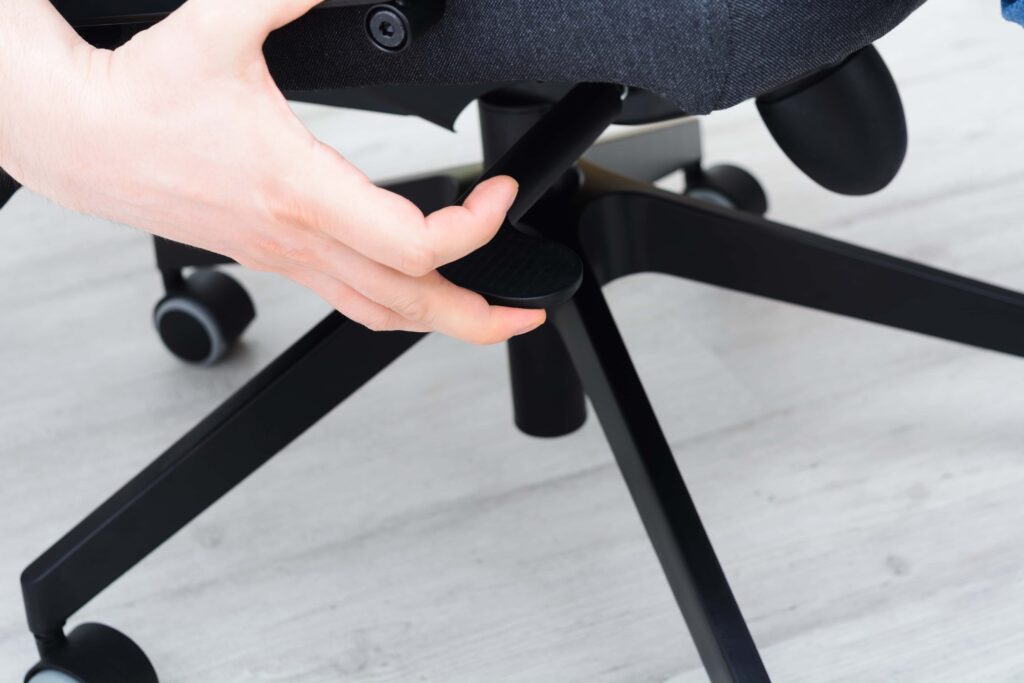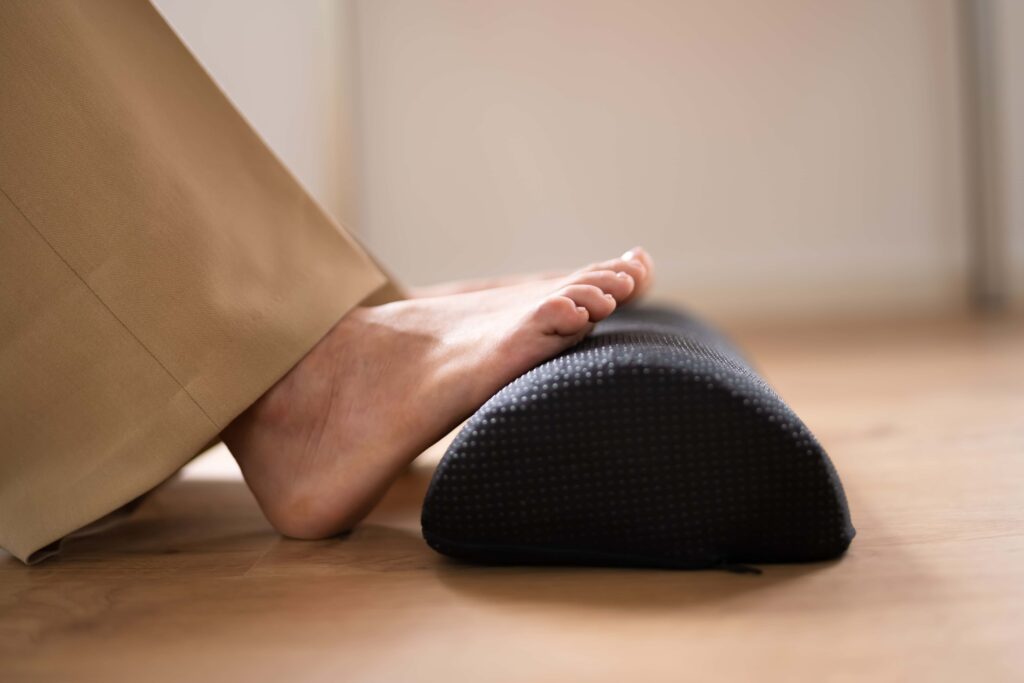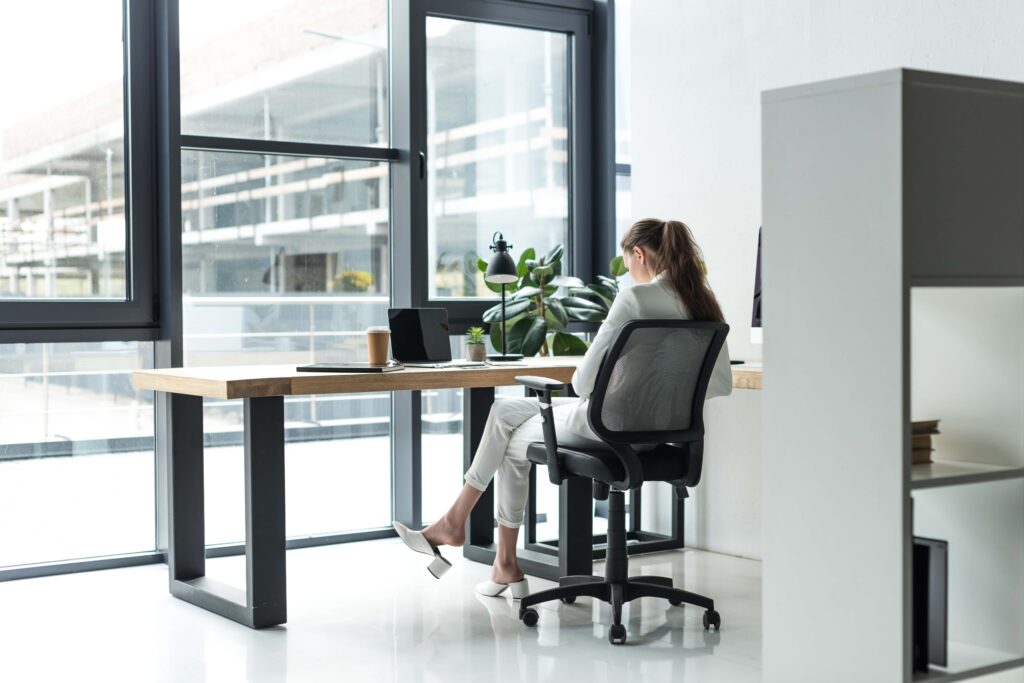How to Make Your Office Chair More Comfortable: The Right Way!
Just like you, millions around the world settle into their office chairs, often to find discomfort instead of relief. It’s high time you turned your chair into a throne of ease.
As you scour through this guide, you’ll learn the ins and outs of chair ergonomics, ensuring every part of your body’s well taken care of.
You’ll start by adjusting the chair height so your feet aren’t left hanging and your thighs rest easy.
Then, add a curve-hugging lumbar pillow to banish back pain.
A soft, supportive seat cushion will be your next step, followed by tweaking the armrests for shoulder and arm relief.
To round it all off, you’ll discover the ideal setup for wrist and foot support, along with the perfect monitor height to keep eye strain at bay.
Let’s make your daily grind a comfortable ride.
Key Takeaways
- Utilize lumbar support pillows and seat cushions to alleviate lower back pain and promote proper posture.
- Use ergonomic footrests to provide support and maintain proper posture, especially for shorter individuals.
- Add gel wrist rests and consider using a wireless, ergonomic mouse to reduce wrist strain.
- Adjust the height of your chair, desk, and monitor to maintain proper alignment and prevent discomfort and potential back problems.

Adjust Office Chair Height Properly for Comfort
To make sure you’re sitting comfortably, there are a few adjustments you can make.
First, adjust your chair height so that your hips and knees are aligned at a right angle. If you find that you’re coming up short, you can add a seat cushion to boost your height.
In addition to adjusting your chair, don’t forget to adjust your monitor as well. Position it at eye level to prevent your neck from straining.
These simple adjustments can go a long way in promoting a more comfortable and ergonomic sitting position.
Align Hips, Knees
Why settle for discomfort when you can adjust your chair height to align your hips and knees for better posture? Attaining proper posture isn’t just about comfort; it’s about maintaining your body’s health. Here’s how to ensure you’re sitting right:
- Adjust the height of your chair so that your feet rest flat on the floor, with your hips and knees at a 90-degree angle.
- If you’re shorter, add an ergonomic seat cushion to raise your seating position.
- Place a lumbar support pillow against the curve of your lower back for added comfort.
- Always reassess your posture throughout the day to maintain that proper posture.
With these simple adjustments, long hours at the desk won’t take as much of a toll on your body.
Seat Cushion Height
Kick up your comfort by adjusting your chair height so your seat cushion allows your feet to rest flat on the floor and your knees to bend at a right angle. This simple tweak ensures you’re not straining your legs or back.
If the chair height is too low, an ergonomic seat cushion can give you the lift you need for a healthier sitting position. A good cushion not only raises the seat cushion height but also supports your posture, distributing your weight evenly.
Monitor Eye Level
You’ll need to adjust your chair height so that your eyes are in line with the top third of your monitor screen, ensuring you’re not looking up or down at an uncomfortable angle. This prevents craning your neck and promotes better posture throughout the workday.
Here are smart modifications to ensure your monitor or laptop is at the correct eye level:
- If the top of the monitor isn’t at eye level, use a stand or a stack of books to elevate it.
- For laptops, consider a laptop stand to achieve the ideal height.
- Adjust the tilt of your screen to avoid glare and to maintain a direct line of sight.
- Remember to periodically reassess your posture, as slouching can lower your eye level.
Enhancing Lumbar Support for your Office Chair
To enhance lumbar support and alleviate back pain, add a lumbar support pillow to your chair for a more comfortable and ergonomic seating arrangement. These specialized cushions are designed to fit the curve of your lower back, providing the back support you need to maintain proper posture throughout the day.
With an ergonomic office chair and a lumbar pillow, you’re well on your way to a healthier sitting experience.
You’ll find that a quality lumbar pillow is typically made of memory foam, which contours to your body and offers relief from pressure and pain. The beauty of these pillows lies in their simplicity and effectiveness. By supporting your lower back’s natural arc, they help distribute your weight evenly and prevent the slumping that leads to discomfort.
Most lumbar pillows come with adjustable straps to secure them to your chair, ensuring they stay in place as you move. This feature is key because consistent support is crucial for preventing strain and potential back problems. Not only do these pillows help you maintain proper alignment, but they’re also an affordable option to enhance your chair’s comfort without the need for a complete overhaul.
Remember, ergonomic office chairs are designed with lumbar support in mind, but they may not fit everyone’s body perfectly. Adding a lumbar pillow can fine-tune the level of support and comfort to match your unique needs.
Optimize Seat Cushioning for Maximum Comfort
Enhancing comfort, a well-chosen seat cushion provides both relief from prolonged sitting and ensures your posture remains optimal. When selecting the perfect cushion, you’re not just looking for a soft place to land. It’s about finding the ideal blend of support and comfort to make those long hours at your desk more bearable.
Firstly, consider the material. Memory foam is a popular choice for seat cushioning because it conforms to your body’s shape, providing personalized support. It’s crucial, though, to look for high-density memory foam that’ll maintain its shape and support over time.
Here are a few tips to optimize your seat cushioning:
- Choose an Ergonomically Designed Cushion: Ensure it promotes proper spinal alignment and distributes your weight evenly.
- Look for a Cushion with a Comfortable Cover: A breathable, washable cover contributes to hygiene and overall comfort.
- Consider Thickness and Firmness: Not too soft, not too firm; it should be just right to prevent bottoming out and to support your pelvic area effectively.
- Check for Special Features: Some cushions come with a non-slip bottom or built-in handle for easy transport.
A good seat cushion can also act as a booster if your chair is too low, aligning your knees with your hips to encourage a natural sitting position. Remember, a cushion isn’t just a pillow for your butt; it’s an essential support tool that can alleviate discomfort and prevent potential back problems.
Incorporate these elements into your office setup and feel the difference in your daily work routine. Comfortable and supportive seat cushioning can transform your office chair from a mere piece of furniture into a throne of productivity.
Fine-Tune Office Chair Armrest Position
Adjusting your armrests to the correct height can significantly improve your upper body’s comfort and reduce strain on your shoulders and spine. When your armrest position is just right, it supports not just your elbows but your entire upper spine, encouraging a posture that’s both comfortable and beneficial for long hours at your office chair. To make your office chair serve you better, start with the armrests. They should be at a height where your elbows rest naturally, allowing your shoulders to remain relaxed and your wrists in a neutral position while you type or navigate with your mouse.
While seated comfortably against the back of your chair, check if your forearms are parallel to the floor when resting on the armrests. If they’re not, most chairs allow you to adjust the armrest height. Simply raise or lower them until you find that sweet spot. Remember, your elbows shouldn’t be forced upward or be left drooping, as either extreme can contribute to muscle tension and fatigue.
In addition to height, the width of your armrests matters too. They should be close enough to your body to offer support without causing you to hunch your shoulders, yet wide enough to allow for easy entrance and exit from your office chair. If your chair has adjustable armrests, bring them in or out to the ideal width for your body size.
Fine-tuning your armrest position is a key step to make your office chair the throne of productivity and comfort it should be. Get this right, and you’ll feel the difference in your comfort levels almost immediately.

Office Chair Comfort by Adding Wrist and Foot Support
After fine-tuning your armrests for optimal upper body support, you’ll also want to consider wrist and foot support to further enhance your office chair’s comfort and ergonomics. When you’re sitting for long hours, it’s crucial to maintain a posture that minimizes stress on your body.
Here’s how you can ensure your wrists and feet get the support they need:
- Make sure your feet are flat on the floor. If your feet dangle, it can lead to poor circulation and discomfort. An ergonomic footrest can help maintain the natural arch of your foot and promote better blood flow.
- If a standard footrest doesn’t quite fit your needs, a footrest pillow is a great alternative. This can provide a soft yet firm support that adjusts to the contour of your feet, offering comfort throughout your workday.
- For your wrists, consider attaching a gel pad to your desk area. This will cushion your wrists while typing and using the mouse, preventing strain and potential injuries.
- Ensure your keyboard and mouse are at a height that allows your wrists to be straight and relaxed. An adjustable desk or keyboard tray can help achieve this ergonomic alignment.

Set Correct Monitor Height for Seating Comfort
You’ll want to adjust your monitor so that your eyes align slightly below the top of the screen, which helps reduce neck strain.
A laptop stand or monitor arm can offer the flexibility you need to get this just right, avoiding any need to gaze downward.
These adjustments are simple yet crucial for maintaining both comfort and focus throughout your workday.
Eye Level Adjustment
To maintain proper neck alignment and prevent discomfort, set your monitor so that your eyes are slightly below the top edge of the screen. Implementing eye level adjustment is crucial for reducing neck strain. Here’s how you can achieve the correct monitor height:
- Use a laptop stand to elevate your screen if you’re working on a laptop.
- Adjust the monitor so it’s about 2-3 inches below the top edge to keep your neck straight.
- Ensure your screen is centered in your direct line of sight to minimize turning or craning your neck.
- If using an external monitor, consider a monitor arm for greater flexibility and precise positioning.
This setup will help you stay comfortable and maintain proper posture throughout your workday.
Reduce Neck Strain
Adjusting your monitor to the correct height is essential for reducing neck strain and maintaining a comfortable viewing angle. When your screen is too low, you’re forced to bend your head down, leading to discomfort. To make your office chair more comfortable and uphold better posture, set your monitor so your eye level is just slightly below the top of the screen.
This ergonomic tweak goes a long way in preventing back pain and supports a more aligned spine.
Consider using a laptop stand or an adjustable monitor arm for flexibility. By ensuring your monitor is at the ideal height, you’ll reduce neck strain and feel the difference in your workday.
Laptop Stand Benefits
Incorporating a laptop stand into your workspace elevates your screen to the perfect eye level, reducing neck strain and enhancing overall comfort. When you’re sitting for long hours, it’s essential to make work as pain-free as possible. A laptop stand is an ergonomic solution that helps mitigate pain and discomfort. Here’s why it’s a game-changer:
- Aligns your sightline with the screen, preventing you from slouching.
- Encourages a healthier posture, reducing the risk of musculoskeletal issues.
- Keeps your workspace organized and clutter-free, which can improve focus.
- Allows for better air circulation around your laptop, preventing overheating.
Monitor Arm Flexibility
While setting your monitor to the correct height is crucial for comfort, using a monitor arm can provide the flexibility you need to achieve the perfect position.
An ergonomic setup isn’t complete without considering monitor arm flexibility. It ensures that your screen aligns with your eye level, which is just slightly below the top of the monitor. This alignment is vital to avoid neck strain and maintain an upright posture.
With a monitor arm, you gain the ability to move your screen in accordance with the height of your chair and desk. This dynamic adjustment allows you to move the monitor closer or farther away, or even to tilt and swivel it for the best viewing angle. It’s all about creating a seamless and adaptable workstation that meets your individual needs.
Avoid Downward Gaze
You’ll prevent neck strain and improve your posture by ensuring your monitor is at the correct height, which is just below eye level. This adjustment is crucial, especially when you’re spending hours at your desk.
To get it right, follow these steps:
- Use a monitor stand or adjustable arm to elevate your screen.
- Ensure the top of the monitor is level with your eyes to avoid a downward gaze.
- Angle the monitor to keep the screen’s center directly in your line of sight.
- Choose the right chair that allows you to sit with your back supported and feet flat on the floor.
These simple changes can make a significant impact on your comfort and prevent back pain, making your workspace ergonomically sound.
Comfortable Seating by the Use of Ergonomic Accessories
You’ve adjusted your chair and monitor, but to seal the deal on comfort, it’s time to pick the right ergonomic accessories.
Consider adding a lumbar pillow for back support, a seat cushion for even weight distribution, and an adjustable footrest to keep your posture in check.
Don’t overlook wrist supports and an ergonomic mouse to minimize strain during those long hours of work.
Choose Lumbar Pillows
Your office chair’s comfort can be significantly enhanced by selecting the right lumbar support pillow, which not only promotes proper posture but also alleviates back pain effectively. When choosing the best ergonomic accessories for a healthy back, consider the following:
- Material: Opt for a memory foam pillow that molds to the contour of your spine, providing tailored support.
- Size: Ensure the pillow fits the back of your chair and corresponds with the curve of your lower back.
- Adjustability: Look for options with adjustable straps to secure the pillow and prevent it from slipping.
- Durability: Choose a high-quality pillow designed to withstand long periods of use and help relieve back tension throughout your workday.
Invest in your back health by selecting the right lumbar support today.
Optimal Seat Cushions
Choosing the right seat cushion is essential for enhancing your office chair’s comfort and supporting your posture throughout the day. To find the best fit, consider a cushion that raises your butt to align your knees with your thighs, ensuring you sit comfortably with your feet flat on the floor. This adjustment can make your workday much more comfortable, especially if you’re dealing with a saggy or hard seat.
Make sure the cushion you select is ergonomically designed to relieve any back pain or sciatica symptoms you might have. It should also be firm enough to provide support without losing shape.
With the right seat cushion, you’ll notice an immediate improvement in both comfort and posture.
Adjustable Footrest Benefits
Incorporating an adjustable footrest into your office setup can significantly enhance your seating ergonomics and overall comfort. Here’s how:
- Promotes Proper Posture: Keeping your feet flat on a footrest helps maintain the natural curve of your spine, reducing strain.
- Increases Circulation: Adjustable footrest benefits include improved blood flow, especially important during long hours of sitting.
- Prevents Pain: By allowing you to keep your feet flat and at the correct height, a footrest can alleviate pressure on your lower back.
- Versatility: With its adjustability, the footrest caters to your personal comfort needs, adapting as you move and change positions.
Ergonomic Wrist Supports
In addition to an adjustable footrest, consider ergonomic wrist supports to further enhance your desk’s comfort and functionality. These supports make a world of difference during those long hours sitting at your computer. By cushioning your wrists, they keep strain and fatigue at bay, allowing you to work more comfortably and effectively.
Ergonomic wrist supports, often made from memory foam, conform to your wrists’ natural contours. They’re a simple yet essential addition to your office furniture, ensuring that you maintain a neutral wrist posture. Available on platforms like Amazon, these adjustable wrist pads are easy to integrate with your existing setup.
Don’t overlook this small but crucial detail in creating an ergonomic workspace that supports you through every task.
Importance of Ergonomic Mourse
While you’re adjusting your chair and desk for comfort, don’t forget that an ergonomic mouse can significantly reduce the strain on your wrist and forearm. An ergonomic mouse aligns your hand and arm in a natural position, preventing discomfort and potential injury. Here’s why it’s essential:
- It supports your wrist’s natural angle, avoiding awkward postures.
- The design encourages a more comfortable grip, reducing hand fatigue.
- Its placement should allow your feet to rest flat on the floor, enhancing overall posture.
- Combined with an ergonomic chair, it fosters a cohesive, strain-free workspace.
Chair Height Adjustment
Adjust your chair height to ensure your hips and knees are aligned at a comfortable angle, enhancing your overall posture and reducing discomfort. Proper chair height adjustment is crucial, especially if you’re sitting for long hours. Your feet should be flat on the floor, supporting your lower body and preventing strain. If they’re not, it might break your back over time.
Don’t let an ill-fitting chair height be the reason you’re uncomfortable. If your chair can’t be adjusted low enough, a footrest can ensure your feet are flat and offer the stability you need. Conversely, a seat cushion can give you the lift needed for your thighs to remain parallel to the floor. These smart, ergonomic accessories can make a world of difference in your daily comfort.
Armrest Positioning Guide
After setting your chair to the ideal height, you’ll want to turn your attention to the armrests to ensure they’re providing optimal support and comfort for your arms and shoulders.
If you’re spending long hours at a desk, a chair that’s not ergonomically sound can lead to back pain and overall discomfort.
Here’s a quick armrest positioning guide to follow:
- Ensure the armrests are at a height where your elbows rest comfortably at a 90-degree angle.
- Adjust the width so you can easily enter and exit the chair.
- Check that your wrists are in a neutral position to prevent strain.
- Consider ergonomic accessories like memory foam armrest pads for extra cushioning.
This setup is crucial, especially if you’re alternating between sitting and using a standing desk.
Supportive Keyboard Trays
To enhance your desk setup, you’ll need a supportive keyboard tray that aligns with your ergonomic accessories for a strain-free workday.
If you’re spending long hours at your desk, it’s essential to have the best setup to prevent discomfort. Supportive keyboard trays are designed to adjust to the ideal height, ensuring that your arms, shoulders, and wrists remain relaxed. These trays complement your chair’s adjustments, allowing you to maintain a natural, healthy posture.
By incorporating a keyboard tray, you’ll notice a significant reduction in strain, especially on those days filled with endless typing.
Make the smart choice for your health and comfort by adding one of these essential ergonomic accessories to your office space.
Maintain Posture and Movement
You’ve got the right gear, but comfort isn’t just about equipment; it’s how you use it. Start by adjusting your chair and desk to maintain a neutral posture, ensuring your feet are flat on the ground or on a footrest.
Encourage Frequent Movement
While adjusting your office chair can significantly increase comfort, it’s also crucial that you take regular breaks to move and stretch, maintaining both posture and circulation.
Sitting for long hours in a cheap desk chair or even high-end chairs makes working a pain, literally. To combat this, encourage frequent movement:
- Stand up every 30 minutes to stretch and walk around.
- Change your sitting position regularly to prevent stiffness.
- Incorporate a sit-stand desk into your workspace, if possible.
- Use apps or timers to remind you to move or adjust your posture.
These steps help to reduce the strain of prolonged sitting and keep your body feeling more comfortable throughout the day.
Adjust for Neutral Posture
Adjusting your chair to achieve a neutral posture is the next crucial step after considering frequent movement to ensure you’re maintaining both comfort and circulation throughout your workday. If you’re spending long hours at a desk that resembles a dining table in height and comfort, it’s time to make some changes.
Start by aligning your hips and knees at a 90-degree angle. You might need a seat cushion for that extra height. Ensure your feet are flat on the floor or on a footrest, with your knees slightly higher than your hips.
Add a lumbar support pillow for your lower back to prevent pain, and adjust the armrests so your elbows are supported and your wrists remain neutral. These tweaks are essential for a pain-free work experience.
Promote Dynamic Sitting
To maintain your posture and encourage movement throughout the day, it’s important to practice dynamic sitting in your office chair. This approach not only helps alleviate discomfort but also promotes better circulation and muscle engagement.
Here are four key ways to promote dynamic sitting:
- Adjust your chair height so your hips are slightly higher than your knees, facilitating easy leg movement.
- Use a seat cushion to elevate your seating position, ensuring your thighs are parallel to the ground.
- Incorporate a lumbar support pillow to avoid slouching and to support the natural curve of your spine.
- Make a habit of changing your sitting position regularly, alternating between leaning forward and sitting back, to engage different muscle groups and maintain flexibility.
Frequently Asked Questions
How Do I Make My Office Chair More Comfortable?
You’re looking to boost your chair’s comfort, right?
Start by adjusting the height so your feet are flat and knees at hip level.
Add a lumbar pillow for back support, and a seat cushion to ease discomfort.
Ensure your monitor’s at eye level to prevent neck strain.
If your wrists are achy, try a gel rest.
Small changes like these can make a huge difference in your comfort at work.
Why Am I so Uncomfortable in My Office Chair?
You’re uncomfortable in your office chair because it’s likely not tailored to your body’s needs. Without proper support, your posture suffers, leading to discomfort.
By adjusting your chair’s height, adding a lumbar support pillow, using a seat cushion, and ensuring your feet rest flat with a footrest, you’ll promote better alignment and alleviate strain.
How Can I Sit in an Office Chair Without Pain?
To sit pain-free, you need to adjust your chair to support your back and legs properly. Make sure you’re sitting with your feet flat and your knees at hip level.
Use a lumbar pillow for back support and a cushion for extra seat comfort.
Adjust your monitor to eye level to avoid neck strain.
How Do You Sit Comfortably on an Uncomfortable Chair?
You’ve got an uncomfortable chair, so let’s fix that. Start by adjusting your chair height so your feet are flat and knees at hip level.
Add a lumbar support pillow for your back and a seat cushion to ease your tailbone.
Ensure your monitor’s at eye level to avoid neck strain.
Use wrist rests for typing comfort.
Small changes make a big difference, and you’ll be sitting comfortably in no time!
Conclusion
In the pursuit of the ultimate workspace comfort, you’ve mastered the art of ergonomic adjustments, transforming your chair into a throne of unparalleled support. As you settle into your newly crafted cocoon of comfort, don’t overlook the importance of maintaining a clean and pristine environment. Maintenance One is your trusted partner in this endeavor, offering top-notch Commercial and Office Cleaning Services tailored to your unique needs.
Our commitment to excellence ensures that your workspace not only feels inviting but remains a hygienic haven for productivity. Beyond the ergonomic finesse, a clean and organized environment contributes significantly to your overall well-being. So, whether you’re aiming for a pristine office space or seeking comprehensive cleaning solutions for your commercial establishment, Maintenance One is here to help. Reach out to us for all your cleaning needs, and let us elevate your workspace to new heights of comfort and cleanliness. Your thriving and comfortable work environment await – contact Maintenance One today.


